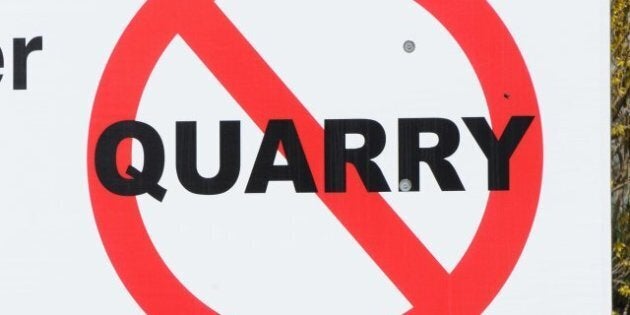
The Melancthon Mega Quarry is dead. A coalition of farmers, foodies, artists, First Nations and environmentalists have stopped the biggest quarry proposal in Canada.
The news spread like wildfire on social media after the Highlands Company announced on Wednesday it was withdrawing its application to build a limestone quarry, citing lack of community support.
The fight against the quarry was more than nimbyism, and all Ontarians are winners. People rallied to protect the fresh water and beautiful farmland of our province. It is clear that we want government to make sure food and water come before aggregates.
The location and scale of the Melancthon Mega Quarry proposal was clearly outrageous. At approximately 2,300 acres, the proposed quarry was a third the size of Toronto. Highlands planned to blast 20 stories below the water table. That's deeper than Niagara Falls. They would need to pump 600 million litres of water per day forever. That's approximately 25 per cent of all the water consumed in Ontario each day.
Shocking.
Given the scale of the proposal, people started asking basic questions: How could anyone contemplate a quarry of this magnitude at the headwaters of five major river systems providing drinking water for millions? Could Ontario afford to lose this much prime farmland? Why does the Ontario government prioritize aggregates over water and farmland?
What started as a small group of farmers concerned about the negative effects of the quarry on the local economy and environment soon became a grassroots movement uniting urban and rural around food and water. Their story is inspiring.
Rural organizers appealed to our stomachs to get city folk involved in the fight. They tapped into the local food movement by distributing lawn signs and buttons at farmers markets. They said put taters before craters.
Local farmer Carl Cosack became a powerful and folksy spokesperson. Artist Sandi Wong engaged the arts community. A small, dedicated group of activists gained media attention by walking from Queen's Park to the proposed location of the quarry, about 100 km northwest of Toronto. Super chef Michael Stadtlander organized chefs for Foodstock, attracting 30,000 people to tiny Melancthon Township. Musicians such as Jim Cuddy and Sarah Harmer performed. A powerful social media campaign took the message to the world.
Politicians got involved. Melancthon Deputy Mayor Darren White had the courage to speak out in the early days before the public was fully engaged. As leader of the Green Party, I was one of the first provincial politicians to take a stand. Eventually members of all four major parties provincially and federally expressed opposition.
Finally, on the eve the 2011 provincial election, the Liberal government buckled to pressure by agreeing to subject the proposal to an Environmental Assessment (EA).
People were outraged that a proposal of this magnitude was not automatically subject to an EA. The fight for an EA exposed loopholes in provincial legislation -- our food and water is not protected. This sent a chilling message to people across the province.
The legacy of the mega quarry fight is that we desperately need an overhaul of the Aggregate Resources Act and the Provincial Policy Statement. Ontario must close the loopholes that fail to protect clean water and preserve prime farmland.
The people of Ontario have sent a strong message. We want laws that put water and food before aggregates.